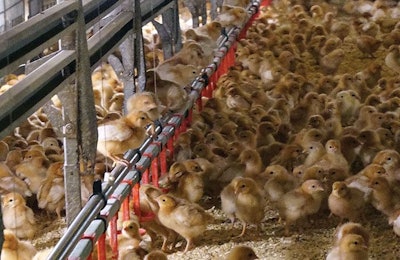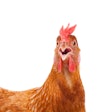
"When you build a layer vaccination program, it's all about defense," said Jim Shirk, manager of the North East Territory with Ceva U.S., during the virtual Pennsylvania Poultry Sales and Service Conference, held by The Pennsylvania State University's College of Agricultural Sciences on September 15 and 16, 2020.
He explained that when building your program, it is important to consider all possible threats you might see throughout the life of your flocks like Mareks, coccidiosis or infectious bursal disease (IBD).
Andy Long, layer and turkey segment sales manager at Ceva, explained that much like in football, building a good defense starts with scouting. "It starts with scouting and knowing your opponent, you need to know what you're up against out there. Once you know what you are fighting against, and what the offense looks like, you can help make your plan and then you can choose your weapons carefully. But you want to be careful to follow the rules to keep everything within the guidelines," Shirk said.
He explained that the chicks, like athletes, do not enter the game without some exposure to the game, so to speak. In the layer industry, this is largely due to the work that the genetic companies are doing to prepare chicks with passive immunity, explained Long.
"They've got some maternal antibodies for things like IBD or Newcastle, and even in this area, they've begun using some variant bronchitis vaccines to try and give a little bit of passive immunity coming through to the chicks and they arrive they're Salmonella free, AI (avian influenza) free, it's all about setting up your best plan for your kickoff," Shirk said.
As producers, it is important to worry about active immunity. The game as they referred to it, which is a hen's life, kicks off in the hatchery. This is where the producer will have the most control. In the U.S., 100% of all layer chicks get vaccinated for Mareks (HVT, Mareks Disease Vaccination). "This is the first place you can really help utilize those scouting reports to know what you're up against," said Shirk.
He explained that the most common defense employed for layers in the industry is to use a vectored IBD. "What it's able to do is standardize your IBD program across multiple hatches from different breeder flocks from across large hatches, and also eliminates the need to have the live IBD time to be out in the field you can eliminate your live IBD plays by using this one customization at the hatchery," said Long.
He noted you could also use an ILT (Infectious laryngotracheitis) vaccine at the hatchery. "If you've got a really early beginning of the game challenge for your birds, where they may have an ITL issue, you can run an HVT ILT at the same time," he said.
This brings in some new plays for layer vaccination known as a zone defense where one can now use HVT, IBD. And we can use ILT at the same time if using a different vector such as the fowlpox ILT product, Long explained.
"It's a great new very effective zone defense. But you do not want to forget about your ground game," said Shirk, as he explained that broad protection for Mareks is still crucial.
Long explained that while still considering the hatchery here, with American vaccinations, there is some new stuff coming. "Now we see more dual insert HVT's coming onto the market. And I think we will probably see those implement themselves into layer vaccination programs as time goes by," said Long.
In the hatchery, producers need a good coccidiosis defense. This vaccine needs to be used in both caged and cage-free birds. "Most of the surveys coming out now are telling us that at least 50% of all pullet chicks in the U.S. get vaccinated for coccidiosis now," Long said.
There are different techniques to run this defense, you can either use a gel drop application where there's direct ingestion or you can use a coarse spray where the birds rely on preening while they're in the checkboxes, Shirk explained.
"We're transitioning into newer technologies like gel drop and gel applied vaccines, which we think give a better uptake," said Long.
Still, in the kickoff phase, known as the hatchery, Shirk and Long explained there are even more live vaccines to consider here. "This is one place where you again need to go back to your scouting and pick and choose the plays that you are going to use because you can be called for too many men in the field. The bird's immune system can only handle so many live vaccines at any given time without compromising some other applications or part of their immune system," said Shirk.
The general rule is two to three live vaccinations at the hatchery. "There's more to give, you just don't want to go past that two to three rule," said Long. All the vaccines have dye in them to monitor the application, so it does not take long to get colorful chicks, he concluded.















